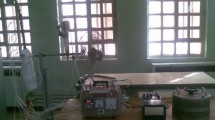Abstract
The thermal predicting/evaluating model of data centers is pivotal in designing their thermal control systems. The existing modeling methods are based on the computational fluid dynamics (CFD) simulations, which is accurate in modeling for a steady-state flow pattern but considerably time-consuming. Besides, the corresponding parameters of CFD have to be re-identified with the deviation of the flow field, which makes it extremely inefficient in real-time thermal control system design of data centers. This paper proposed a machine learning method to derive the fast-temperature evaluation model with a constructed artificial neural network. It learns the relationship between the flow patterns and model parameters based on the system thermal–physical analysis, which replaces the time-consuming CFD-based parameter identifying process. Then, the temperature evaluation is implemented under different flow patterns with the proposed neural-network enhanced modeling method. In the learning process, multi-type of neural networks, i.e., backpropagation network, radial basis function network and extreme learning machine, are considered and compared. The accuracy of the proposed model is validated by comparing with the pure CFD results as the satisfactory standard. With the efficiency and accuracy, the proposed modeling method is more suitable to design real-time controllers for data centers with changing flow fields.














Similar content being viewed by others
References
ASHRAE (2008) 2008 ashrae environmental guidelines for datacom equipment, expanding the recommended environmental envelope
Bai Y, Gu L (2017) Chip temperature-based workload allocation for holistic power minimization in air-cooled data center. Energies 10(12):2123
Banerjee A, Mukherjee T, Varsamopoulos G, Gupta SK (2011) Integrating cooling awareness with thermal aware workload placement for HPC data centers. Sustain Comput Inform Syst 1(2):134–150
Chauvin Y, Rumelhart DE (2013) Backpropagation: theory, architectures, and applications. Psychology Press, Abingdon
Dynamics datacenter (2014) Is the industry getting better as using power? Focus 33:16–17
Demirci M (2015) A survey of machine learning applications for energy-efficient resource management in cloud computing environments. In: 14th international conference on machine learning and applications (ICMLA). IEEE, pp 1185–1190
Fang Q, Wang J, Gong Q (2016) Qos-driven power management of data centers via model predictive control. IEEE Trans Autom Sci Eng 13(4):1557–1566
Fang Q, Wang J, Gong Q, Song M (2017) Thermal-aware energy management of HPC data center via two-time-scale control. IEEE Trans Ind Inform 13(5):2260–2269
Google (2009) Google cluster data. http://code.google.com/p/googleclusterdata/
Gundogdu O, Egrioglu E, Aladag CH, Yolcu U (2016) Multiplicative neuron model artificial neural network based on gaussian activation function. Neural Comput Appl 27(4):927–935
Huang GB, Zhou H, Ding X, Zhang R (2011) Extreme learning machine for regression and multiclass classification. IEEE Trans Syst Man Cybern Part B Cybern 42(2):513–529
Jin XZ, Yang GH, Che WW (2012) Adaptive pinning control of deteriorated nonlinear coupling networks with circuit realization. IEEE Trans Neural Netw Learn Syst 23(9):1345–1355
Kankal M, Uzlu E (2017) Neural network approach with teaching-learning-based optimization for modeling and forecasting long-term electric energy demand in Turkey. Neural Comput Appl 28(1):737–747
Koomey J (2011) Growth in data center electricity use 2005 to 2010. The New York Times 9:161
Li Z, Yang GH (2018) A data-driven covert attack strategy in the closed-loop cyber-physical systems. J Frankl Inst 355(14):6454–6468
Mukherjee T, Banerjee A, Varsamopoulos G, Gupta SK (2010) Model-driven coordinated management of data centers. Comput Netw 54(16):2869–2886
Park J, Sandberg IW (1991) Universal approximation using radial-basis-function networks. Neural Comput 3(2):246–257
Parolini L, Sinopoli B, Krogh BH (2008) Reducing data center energy consumption via coordinated cooling and load management. In: Proceedings of the 2008 conference on power aware computing and systems, HotPower, vol 8, pp 14–14
Parolini L, Sinopoli B, Krogh BH, Wang Z (2012) A cyber-physical systems approach to data center modeling and control for energy efficiency. Proc IEEE 100(1):254–268
Rodan A, Tino P (2010) Minimum complexity echo state network. IEEE Trans Neural Netw 22(1):131–144
Rong H, Zhang H, Xiao S, Li C, Hu C (2016) Optimizing energy consumption for data centers. Renew Sustain Energy Rev 58:674–691
Song M, Chen K, Wang J (2017) Numerical study on the optimized control of CRACs in a data center based on a fast temperature-predicting model. J Energy Eng 143(5):04017013
Tang Q, Mukherjee T, Gupta SK, Cayton P (2006) Sensor-based fast thermal evaluation model for energy efficient high-performance datacenters. In: 4th international conference on intelligent sensing and information processing. IEEE, pp 203–208
Toulouse MM, Doljac G, Carey VP, Bash C (2009) Exploration of a potential-flow-based compact model of air-flow transport in data centers. In: ASME 2009 international mechanical engineering congress and exposition. American Society of Mechanical Engineers, pp 41–50
Xu X, Hua C, Tang Y, Guan X (2016) Modeling of the hot metal silicon content in blast furnace using support vector machine optimized by an improved particle swarm optimizer. Neural Comput Appl 27(6):1451–1461
Yaseen ZM, Allawi MF, Yousif AA, Jaafar O, Hamzah FM, El-Shafie A (2016) Non-tuned machine learning approach for hydrological time series forecasting. Neural Comput Appl 30(5):1–13
Zell A (1994) Simulation of neural networks. Addison-Wesley, Boston
Acknowledgements
This work was supported in part by the National Natural Science Foundation of China (No. 61903134, 61903132), the Funding Projects of Chang-Zhu-Tan National Independent Innovation Zone (No. 2017XK2102) and the Funds of Key Lab in Precise Navigation and Application of Guangxi Province (No. DH201811).
Author information
Authors and Affiliations
Corresponding author
Additional information
Publisher's Note
Springer Nature remains neutral with regard to jurisdictional claims in published maps and institutional affiliations.
Rights and permissions
About this article
Cite this article
Fang, Q., Li, Z., Wang, Y. et al. A neural-network enhanced modeling method for real-time evaluation of the temperature distribution in a data center. Neural Comput & Applic 31, 8379–8391 (2019). https://doi.org/10.1007/s00521-019-04508-y
Received:
Accepted:
Published:
Issue Date:
DOI: https://doi.org/10.1007/s00521-019-04508-y




